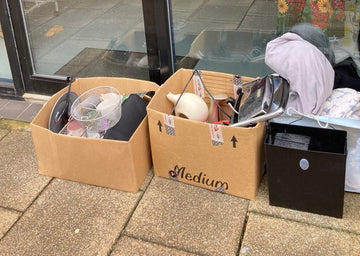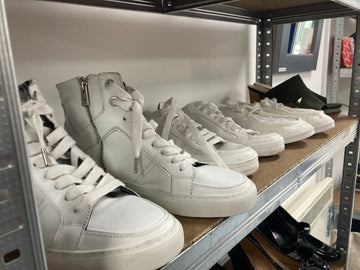Where Does Textile Recycling Go, Really?
Even fast fashion can’t hide its own trail of waste.
And yet it was still shocking to learn just how far some ‘textile recycling’ travels.
It all was discovered by using clever geolocation tags, hidden in clothing placed into recycling bins.
16 geolocation tags were placed into different bins by researchers in Switzerland. According to the study, these recycling bins were used by charities and fast fashion brands like H&M and Zara as part of their take-back schemes.
The results are really quite staggering.
Here’s How Far some Textile Recycling Travels
Your Old T-Shirt Travels The World

Just two out of the 16 garments were sent to be sold in second-hand or charity shops. Even 250 days after the start of the research project, some of the clothes were still in transit.
From Switzerland, the clothing travelled as far as Venezuela and Afghanistan. Half of the clothing ended up in Eastern Europe.
But is this study large enough?
For the billions of clothes that are made each year, tracking where just 16 items of clothing end up might not tell the whole story.
After all, the Ellen MacArthur Foundation estimate that the equivalent of a truck full of clothes is burnt or gets thrown into landfill every second.
Nevertheless, despite the small sample size it still demonstrates just how far our clothes travel after we are finished with them.
We’d like to think that these clothes are travelling to areas where they are in need. Equally, we always have need for clothing within our own communities.
Does it make sense to ship clothes so far afield in order to ‘recycle’ them?
Textile recycling can be really profitable, especially when it involves selling on higher grade clothing that can be reworn, that can fetch higher prices when it can be reworn. This is partly why it 'makes sense' to send these old garments across the world to the highest bidder.
Read More: What Happens to your Online Fashion Returns
Textile Waste in Ghana - How Can We Solve it?

Despite all the textile recycling schemes that exist in the world, we still see those awful photos of old clothing strewn upon beaches in Ghana. These clothes are known locally as “dead White people’s clothes” or obroni wawu”. Too many garments are piling up here. So much so that a landfill site in Accra that was meant to last 25 years filled up in just three. There simply isn’t enough resources to deal with the influx of used clothing.
Fast Fashion Waste in Kenya Burnt for Fuel
Ghana is not the only country that suffers from excess second hand clothing.
A new study by Changing Markets Foundation claims EU countries are dumping as much as 37 million items of garments in Kenya every year. But these items are damaged, soiled or otherwise not fit to be worn, let alone resold.
Lots of these clothes are plastic-based, meaning they can be burnt for fuel. The report found this fast fashion was being burned to heat water, cook and for general power usage.
Recycling firms that are part of Fashion for Good and Textiles 2030 are said to be at fault for this for passing on garments that are entirely unsalvageable.
But Alan Wheeler, speaking on behalf of the Textile Recycling association, said the UK was no longer a significant source of used clothing in Kenya, exporting 7,328 tonnes in 2021. This accounts for about 4% of all used clothing received in Kenya.
In comparison, China has shipped 78,575 tonnes of clothing (43% of all used clothing received in Kenya).
So how do we properly recycle textiles rather than swamping other countries with our own waste?
There are a few ways to reduce textile waste. The first is to move towards a closed-loop recycling system for clothes, so that when you put your old clothing into a textile bank, it either gets reworn or is remade into something else.
5 Circular or Recycled Clothing Brands That Use Recycled Textiles
Rapanui are one brand already thinking about the full life cycle of their fashion items. This clothing brand attaches QR codes to their garments to make it easier to return and track where their old clothing goes. Then Rapanui are able to produce what they call 50:50 based clothing, using half old recycled material and half new materials in their new garments.
So virgin materials are still currently required in some part even for ‘recycled’ clothing.
But recycling clothing is more complicated (as it undergoes more wear and tear) than an aluminium baked bean can, for example.
Lots of other brands also offer clothing that uses recycled textiles. By doing so it generally takes less energy and resources than using virgin fibres.
Lucy and Yak make fleeces that are made 100% from recycled polyester from plastic bottles.
For activewear made from recycle materials, try Thought or Girlfriend Collective who use recycled plastic bottles to make all kinds of activewear.
Earth Wardrobe offers basics at more affordable prices. They use something called regenerated cotton, "derived from cotton waste from the cutting room of cotton garment production which is usually sent to landfill" as well rPET, which is derived from plastic bottles.
Patagonia say they are moving towards using 100% renewable and raw materials across their entire range. Let's not forget their 2011 New York Times ad urging customers "Do Not Buy This Jacket" and their consistent messaging since against wasteful Black Friday consumerism.
Read More: Where to Take Rags and Where to Recycle Clothes
There is no perfection solution to textile waste, except to really cut down on how much new clothing we buy. Instead, we can shop second hand for any garments we may need. This way, we are taking part in the circular economy with very little effort. It shouldn’t take a 250 day journey across the world to rehome your T-Shirt.
Instead we should be able to pop into our local charity shops or second-hand stores to drop off the T-Shirt and find a quality replacement, or another garment that lasts us for a good few years.
Even without physical stores, shopping preloved fashion online is becoming easier and more popular. Resale websites like Vinted, Depop and eBay are growing, with more people turning to second-hand bargains to restock their wardrobes. We are also seeing brilliant clothes swap initiatives like Dopplle.
At some point, clothes do wear out. But there’s even things we can do as individuals to use up old bits of clothing.
So let's enjoy the clothes we already have. Let's wear and rewear them! And let's get clothing to those who need it most rather than it sitting in the back of our wardrobes.




